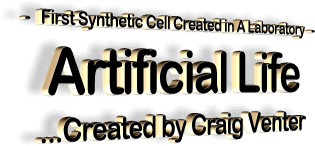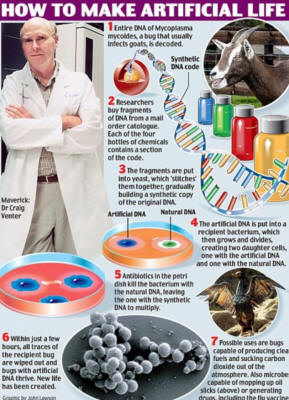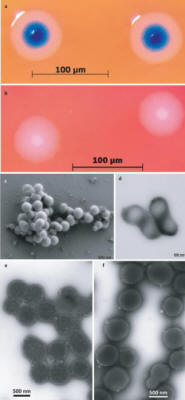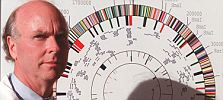|

by Fiona Macrae
May 21, 2010
from
DailyMail Website
|
Scientist
accused
of Playing God after creating Artificial Life by making
Designer Microbe
from Scratch.
But
could it wipe
out humanity? |
Scientists today lined up to air their
fears over a genome pioneer's claims that he has created artificial
life in the laboratory.
In a world first, which has alarmed many, maverick biologist and
billionaire entrepreneur
Craig Venter, built a synthetic
cell from scratch.
The creation of the new life form, which has been nicknamed 'Synthia',
paves the way for customized bugs that could revolutionize
healthcare and fuel production, according to its maker.
But there are fears that the research, detailed in the journal
Science, could be abused to create the ultimate biological weapon,
or that one mistake in a lab could lead to millions being wiped out
by a plague, in scenes reminiscent of the Will Smith film I Am
Legend.

While some hailed the research as 'a
defining moment in the history of biology', others attacked it as 'a
shot in the dark', with 'unparalleled risks'. The team involved have
been accused of 'playing God' and tampering 'with the essence of
life'.
Dr Venter created the lifeform by synthesizing a DNA code and
injecting it into a single bacteria cell. The cell containing the
man-made DNA then grew and divided, creating a hitherto unseen
lifeform.
Kenneth Oye, a social scientist at the Massachusetts
Institute of Technology in the U.S., said:
'Right now, we are shooting in the
dark as to what the long-term benefits and long-term risks will
be.'

This
picture shows the colonies of
the artificial lifeform nicknamed 'Synthia'
Pat Mooney, of the ETC group, a technology watchdog
with a special interest in synthetic biology, said:
'This is a Pandora's box moment -
like the splitting of the atom or the cloning of Dolly the
sheep, we will all have to deal with the fall-out from this
alarming experiment.'
Dr David King, of the Human
Genetics Alert watchdog, said:
'What is really dangerous is these
scientists' ambitions for total and unrestrained control over
nature, which many people describe as 'playing God'.
'Scientists' understanding of biology falls far short of their
technical capabilities. We have learned to our cost the risks
that gap brings, for the environment, animal welfare and human
health.'
Professor Julian Savulescu, an
Oxford University ethicist, said:
'Venter is creaking open the most
profound door in humanity's history, potentially peeking into
its destiny.
'He is not merely copying life artificially or modifying it by
genetic engineering. He is going towards the role of God:
Creating artificial life that could never have existed.'
He said the creation of the first
designer bug was a step towards
'the creation of living beings with
capacities and a nature that could never have naturally
evolved'. The risks were 'unparalleled',' he added.
And he warned:
'This could be used in the future to
make the most powerful bioweapons imaginable. The challenge is
to eat the fruit without the worm.'
Dr Venter, who was instrumental in
sequencing the
human genome, had previously
succeeded in transplanting one bug's genome - its entire cache of
DNA - into another bacterium, effectively changing its species.
He has taken this one step further, transplanting not a natural
genome but a man-made one. To do this, he read the DNA of
Mycoplasma mycoides, a bug that infects goats, and recreated it
piece by piece.
The fragments were then 'stitched together' and inserted into a
bacterium from a different species. There, it sprang to life,
allowing the bug to grow and multiply, producing generations that
were entirely artificial. The transferred DNA contained around 850
genes - a fraction of the 20,000 or so contained in a human's
genetic blueprint.
In future, bacterial 'factories' could be set up to manufacture
artificial organisms designed for specific tasks such as medicines
or producing clean biofuels.
The technology could also be harnessed to create environmentally
friendly bugs capable of mopping up carbon dioxide or toxic waste.
Dr Venter, a 63-year-old Vietnam War veteran known for his showman
tendencies, said last night:
'We are entering a new era where
we're limited mostly by our imaginations.'
But the breakthrough, which took 15
years and £27.7million to achieve, opens an ethical Pandora's box.
Ethicists said he is 'creaking open the most profound door in
humanity's history' - with unparalleled risks.
Dr Venter, whose team of 20 scientists includes a Nobel laureate,
likens the process to booting-up a computer.
Like a program without a hard drive,
the DNA doesn't do anything by itself. But, when the software is
loaded into the computer - in this case the second bacterium -
amazing things are possible, he said.
|
'WATERMARKING' DNA
This dramatic development naturally raises fears of the
dangers these organisms pose. So one idea, which has
been followed through by Venter and his team, is to
'watermark' them.
By weaving these hidden codes in it enables scientists
to trace the organisms to their laboratories and prove
the recipient bacteria contained the synthetic genome.
Researchers used the 'alphabet' of genes and proteins to
spell out messages.
The team created a code that spells out the 26 letters
of the alphabet, the numbers 0 to 9 and several
punctuation marks. They then wrote a message which
reveals the code. A second missive was a string of
'letters' corresponding to the names of 46 people
involved in the project. A third gave an e-mail address
where people can write once they crack the code and the
fourth listed three philosophical quotes. |
Now that the scientist, whose J Craig Venter Institute has
labs in California and Maryland, has proved the concept, the path is
open for him to alter the 'recipe' to create any sort of organism he
chooses.
At the top of his wish-list are bugs capable of producing clean
biofuels and of sucking carbon dioxide out of the atmosphere. Other
possibilities include designer microbes that can mop up oil slicks
or generate huge quantities of drugs, including the flu vaccine.
Any such organisms would be deliberately 'crippled' so that they
cannot survive outside the lab, he claimed.
Brushing aside the ethical concerns of his work, Dr Venter wrote in
his autobiography that it would allow,
'a new creature to enter the world'.
'We have often been asked if this
will be a step too far,' he said. 'I always reply that - so far
at least - we are only reconstructing a diminished version of
what is out there in nature.'
Last night, he claimed the breakthrough
had changed his views on the definition of life.
'We have ended up with the first
synthetic cell powered and controlled by a synthetic chromosome
and made from four bottles of chemicals,' he said.
'It is pretty stunning when you just replace the DNA software in
a cell and the cell instantly starts reading that new software
and starts making a whole new set of proteins, and within a
short while all the characteristics of the first species
disappear and a new species emerges.
'That's a pretty important change in how we approach and think
about life.'
The process was carried out on one of
the simplest types of bacteria, under strict ethical guidelines.
The research team insist that they
cannot think of a day when the technology could be used to create
animals or people from scratch.
Has he created
a monster?
by Michael Hanlon
Science Editor
The creation of a living being in a laboratory is one of the
staples of science fiction. Now it is a scientific fact.
Yesterday's announcement of the birth of
a 'synthetic cell' - made by injecting a bacterium shell with
genetic material created from scratch by scientists - raises many
questions.

There are fears the
research could be abused and lead to millions being
wiped out by a plague
like in the Will Smith film I Am Legend
These range from the mundanely practical - how will this be useful?
- to the profoundly philosophical - will we have to redefine what
life is?
Depending on your viewpoint, it is either a powerful testament to
human ingenuity or a terrible example of hubris - and the first step
on a very dangerous road. To understand what this development means,
we need to discover who the team behind this innovation is.
It is led by Craig Venter, the world's greatest scientific
provocateur, a 63-year-old Utah-born genius, a Vietnam veteran,
billionaire, yachtsman, and an explorer. Above all he is a showman.
A master of self-publicity, he does not do things by halves; he led
the private team which competed with scores of publicly funded
scientists in the U.S. and UK to 'crack' the human genome by
sequencing our DNA.
His rapid, innovative approach led to the possibility he would beat
the scientific establishment.
So, to save face all round, the human genome was presented as a
joint achievement. At around the same time, he began talking
about making an artificial lifeform in the lab.
Not a Frankenstein's monster, or even a mouse, but a bacterium, one
of the simplest living organisms. His blueprint was to be an
unassuming and harmless little germ with only 485 genes (humans have
around 25,000).
Venter talks grandly of a supercharged biotech revolution, with
synthetic bacteria designed to produce biofuels, to mine precious
metals from rocks and industrial waste, to digest oil slicks and
render toxic spills harmless.
|
WHO IS CRAIG VENTER?
Craig Venter is a controversial biologist and
entrepreneur who led the effort by the private sector to
sequence the human genome.
He was vilified by the scientific community for turning
the project into a competitive race but his efforts did
mean that the human genome was mapped three years
earlier than expected.

Born in 1946, Dr Venter was an average scholar with
a keen interest in surfing.
It was while serving in Vietnam and tending to wounded
comrades that he was inspired to become a doctor.
During his medical training he excelled in research and
was quick to realize the importance of decoding genes.
In 1992 he set up
the private
Institute for Genomic Research.
Then a mere three
years later he stunned the scientific establishment by
revealing the first complete genome of a free-living
organism that causes childhood ear infections and
meningitis.
In 2005 he founded the private company
Synthetic Genomics,
with the aim of engineering new life forms the would
produce alternative fuels.
He was listed on Time Magazine's 100 list of the most
influential people
in both 2007 and 2008. |
Scientists could even create bacteria which can produce novel drugs
and vaccines, or organisms engineered to live on Mars and other
planets.
The potential is huge - but so are the dangers.
An artificial species, created in the
lab, might not 'obey the rules' of the natural world - after all,
every living being on Earth has evolved over three billion years,
when a myriad of competing species have had to share the same
increasingly crowded environment.
It is possible to imagine a synthetic microbe going on the rampage,
perhaps wiping out all the world's crop plants or even humanity
itself.
Synthetic biology also challenges our most cherished notions
of what life itself actually is. Non-scientists might not realize
that we have, as yet, no proper definition of life.
A diamond is not alive; a baboon clearly is. But what about a virus?
Viruses, which are even simpler than bacteria, have a
genetic code written in DNA (or its cousin RNA).
The stuff viruses are made from is the stuff of life - protein coats
and so on - yet they cannot reproduce independently.
Like diamonds, they can be grown into crystals - and you certainly
cannot crystallize baboons. Most biologists say viruses are not
alive, and that true biology begins with bacteria.
So is Synthia, Venter's tentative name for his new critter, alive?
It is certainly not the result of
Darwinian evolution, one of the
(many) definitions of life. It is more 'alive' than any virus but it
is the product of Man, not of evolution. Its genetic code is simple
enough to be stored on a computer (but then again, so is ours).
Whatever the answer to this fundamental question, Venter's
breakthrough is certainly the final rebuttal to the old notion of a
vital spark - a mysterious essence that divides the quick
from the dead. If you can carry around a genome on a computer memory
stick and make a cell using a few simple chemicals, then the old
idea of 'vitalism' is truly dead.
Of course, this is early days. It is not yet clear if Venter can
negotiate the final step - creating a whole cell from scratch, using
no bits of existing living organisms at all.
His bacterium is likely to be weak and feeble; we are a long way
from synthetic super-plagues, and even further from an artificial
animal or plant. But it is hard to escape the feeling that a
boundary has been crossed.
The problem is, it is far from clear
where we go from here.
Video
|





